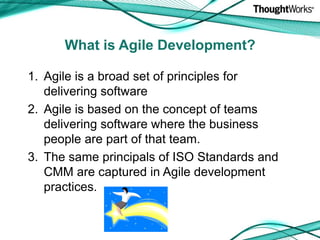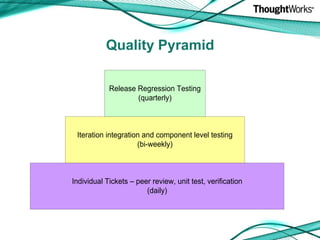Baby Steps To Agility
- 1. Baby Steps to AgilityHow to Grow Into Agile
- 2. GoalsA little about meA little about AgileGrowing into AgileQuestions
- 3. About meI want to deliver great software.Almost 20 years experience in softwareExperience managing a 200+ person programUsing Agile Methods since 2000.Agile is a better way.
- 4. The Agile ManifestoAgile PrefersIndividuals and interactionsWorking SoftwareCustomer collaborationResponding to changeOverProcesses and toolsComprehensive documentationContract negotiationFollowing the plan
- 5. 12 Agile PrinciplesOur highest priority is to satisfy the customerthrough early and continuous deliveryof valuable software.Welcome changing requirements, even late in development. Agile processes harness change for the customer's competitive advantage.Deliver working software frequently, from a couple of weeks to a couple of months, with a preference to the shorter timescale.Business people and developers must work together daily throughout the project.Build projects around motivated individuals. Give them the environment and support they need, and trust them to get the job done.The most efficient and effective method of conveying information to and within a development team is face-to-face conversation.Working software is the primary measure of progress.Agile processes promote sustainable development. The sponsors, developers, and users should be able to maintain a constant pace indefinitely.Continuous attention to technical excellence and good design enhances agility.Simplicity--the art of maximizing the amount of work not done--is essential.The best architectures, requirements, and designs emerge from self-organizing teams.At regular intervals, the team reflects on how to become more effective, then tunes and adjusts its behavior accordingly.
- 6. Sitting up – Why Change?Starting to Crawl - Pick ChangeFirst Steps - Team focus and “buy-in”Speaking in Sentences - Agile ReportingPatience – Continuing to ChangePractice Development Milestones
- 7. Define the current stateIdentify the problemsWrite down the reasons for ChangeSitting Up
- 8. Product CompanyPatches and UpgradesInternal ITPoint SolutionsProfessional ServicesWorking Software QuicklyHow Does “The Business” Work
- 9. We don’t know when we are done.We test functionality and it is not working in the build we give to the customer.Our customer is constantly changing his mind.How is this software supporting “the business”?Some Problems
- 10. We are only going to work on things that are important to our customers.We can guarantee delivery of the product on time with known quality.We can clearly define what is in a release and what is not in a release.We can report the outcome of our testing to a customer.We can deliver important customer issues outside of a release.How is this going to help us?
- 11. Build of the system that includes installation packages and automated test.
- 12. Iterative process for delivering.
- 13. Complete TicketsStarting to Crawl
- 14. Build
- 15. Test
- 16. ReportWhat does the Build look like?
- 17. What does Iterative Development look like?
- 18. When is a Ticket DoneReplication of the issue or RequirementsAnalysis and Review of SolutionTest CasesUnit testImplementationCode ReviewVerificationDocumentationRelease for System Integration.
- 19. Have the Team Define SolutionSpend Time in a Dark Room with Power PointClose the Feedback LoopFirst Steps
- 20. Ticket process as defined by Team
- 21. What is Agile Development?Agile is a broad set of principles for delivering softwareAgile is based on the concept of teams delivering software where the business people are part of that team.The same principals of ISO Standards and CMM are captured in Agile development practices.
- 22. What Agile is not.Agile is not a rigid set of instructions.Agile is not a silver bullet.Agile is not anti-documentation.
- 23. Team RetrospectiveManagement RetrospectiveReporting on ActionsCircle the Ideas
- 24. Agile Performance IndicatorsDefine a PointQualitySpeaking in Sentences
- 25. Velocity – How fast are we going?Capacity – How much can we do?Burn up / down - When are we going to finish?Backlog – How much is there to do?Burn rate – How much does it cost?Progress – How are we doing on initiatives?Agile Performance Indicators
- 26. Define a Point
- 27. Quality Pyramid
- 28. Patience
- 29. Questions

























